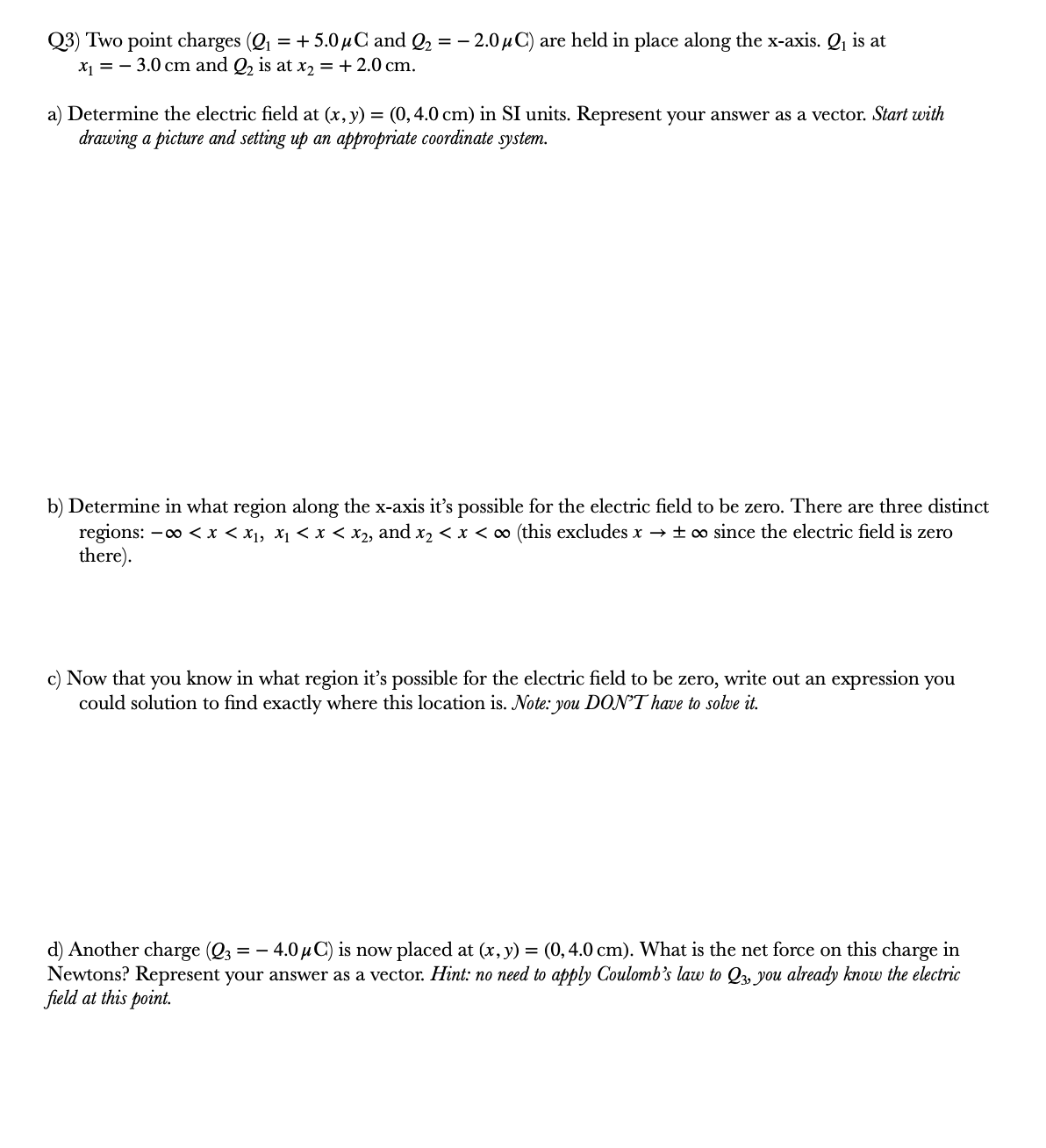Q3) Two point charges (Q = + 5.0 µC and Q2 = – 2.0 µ C) are held in place along the x-axis. Q, is at x1 = - 3.0 cm and Q, is at x2 = + 2.0 cm. a) Determine the electric field at (x, y) = (0, 4.0 cm) in SI units. Represent your answer as a vector. Start with drawing a picture and setting up an appropriate coordinate system.
Q3) Two point charges (Q = + 5.0 µC and Q2 = – 2.0 µ C) are held in place along the x-axis. Q, is at x1 = - 3.0 cm and Q, is at x2 = + 2.0 cm. a) Determine the electric field at (x, y) = (0, 4.0 cm) in SI units. Represent your answer as a vector. Start with drawing a picture and setting up an appropriate coordinate system.
College Physics
1st Edition
ISBN:9781938168000
Author:Paul Peter Urone, Roger Hinrichs
Publisher:Paul Peter Urone, Roger Hinrichs
Chapter18: Electric Charge And Electric Field
Section: Chapter Questions
Problem 54PE: Earth has a net charge that produces an electric field of approximately 150 N/C downward at its...
Related questions
Question

Transcribed Image Text:Q3) Two point charges (Q = + 5.0 µC and Q2 = – 2.0 µ C) are held in place along the x-axis. Q, is at
x1 = - 3.0 cm and Q, is at x2 = + 2.0 cm.
a) Determine the electric field at (x, y) = (0,4.0 cm) in SI units. Represent your answer as a vector. Start with
drawing a picture and setting up an appropriate coordinate system.
b) Determine in what region along the x-axis it's possible for the electric field to be zero. There are three distinct
regions: -o < x < x1, X1 < x < x2, and x2 < x < ∞ (this excludes x → ±∞ since the electric field is zero
there).
c) Now that you know in what region it's possible for the electric field to be zero, write out an expression you
could solution to find exactly where this location is. Note: you DON'T have to solve it.
d) Another charge (Q3
Newtons? Represent your answer as a vector. Hint: no need to apply Coulomb's law to Q3, you already know the electric
field at this point.
4.0 µ C) is now placed at (x, y) = (0,4.0 cm). What is the net force on this charge in
= -
Expert Solution
This question has been solved!
Explore an expertly crafted, step-by-step solution for a thorough understanding of key concepts.
Step by step
Solved in 3 steps with 2 images

Knowledge Booster
Learn more about
Need a deep-dive on the concept behind this application? Look no further. Learn more about this topic, physics and related others by exploring similar questions and additional content below.Recommended textbooks for you

College Physics
Physics
ISBN:
9781938168000
Author:
Paul Peter Urone, Roger Hinrichs
Publisher:
OpenStax College

Physics for Scientists and Engineers
Physics
ISBN:
9781337553278
Author:
Raymond A. Serway, John W. Jewett
Publisher:
Cengage Learning

Physics for Scientists and Engineers with Modern …
Physics
ISBN:
9781337553292
Author:
Raymond A. Serway, John W. Jewett
Publisher:
Cengage Learning

College Physics
Physics
ISBN:
9781938168000
Author:
Paul Peter Urone, Roger Hinrichs
Publisher:
OpenStax College

Physics for Scientists and Engineers
Physics
ISBN:
9781337553278
Author:
Raymond A. Serway, John W. Jewett
Publisher:
Cengage Learning

Physics for Scientists and Engineers with Modern …
Physics
ISBN:
9781337553292
Author:
Raymond A. Serway, John W. Jewett
Publisher:
Cengage Learning

Principles of Physics: A Calculus-Based Text
Physics
ISBN:
9781133104261
Author:
Raymond A. Serway, John W. Jewett
Publisher:
Cengage Learning

College Physics
Physics
ISBN:
9781285737027
Author:
Raymond A. Serway, Chris Vuille
Publisher:
Cengage Learning

College Physics
Physics
ISBN:
9781305952300
Author:
Raymond A. Serway, Chris Vuille
Publisher:
Cengage Learning